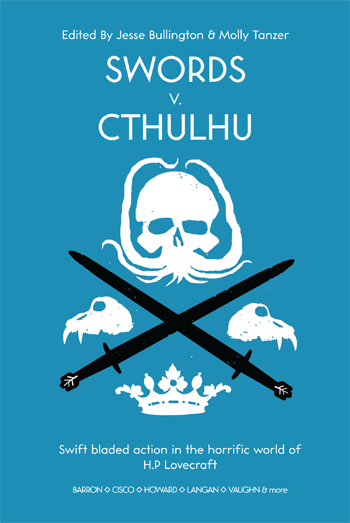As outlined in an earlier post, in the coming weeks I will be dedicating an entry to each story in the upcoming anthology Swords v Cthulhu, edited by Molly Tanzer and Jesse Bullington and published by Stone Skin Press. My reviewing method will be peppered with the cultural associations that each of these stories inspire. These will be presented with no excuse, apology or editorial justification.

Trespassers by A. Scott Glancy
Even in these supposedly more enlightened times, the trappings of colonial adventure never fail to seduce and enthrall. While we may acknowledge that the bedrock of what makes all the stories of white people venturing into dark lands for booty and triumph as suspect, a primordial gland in our brain will always be attracted to these narratives.
The reasons, a lot of the time, are quite obvious: leaping into the exotic and the unknown feels easier and more legitimized when you have the churning hegemonic power of an imperial/colonial machine behind you, and so these ‘thrilling yarns’ — as they end up being called with alarming regularity — come with enough requisite hand-holding to make them as comfortable as they are exciting.
The ‘have your cake and eat it too’ version of these narratives is embodied quite explicitly in the recent Oscar-baiter movie The Revenant. Once you machete your way through the long-telegraphed hype about just how hard it was to make, you’ll find an adventure story whose moral ambiguity and caked-on grime is the only sop to it existing in the 21st century.
The same — aforementioned — gland is satisfied by the rollicking and blinkered tales of H. Rider Haggard and in fact, Glancy’s contribution to the anthology begins with the words, “Rider approaching!”

Adventure time? The Revenant (2015)
What follows is the journey of an unwittingly cosmopolitan group of explorers and their misadventures across the treacherous Kunlun Mountain chain in China. An expedition that includes Brits, Russians, Germans and Indians is enough to cause its own drama — add some Lovecraftian horror into that mix and you’ve got yourself a heady melange of historical drama and eldritch inventiveness.
The ‘pygmies’ that serve as the antagonists of the piece are yet another reminder of the ‘have your cake and eat it too’ dynamic that also powers The Revenant. Because in many ways, they slot in ‘nicely’ with the various grotesques of Lovecraft’s own canon — strange races which serve as uncomfortable reminders of their author’s intrinsic discomfort with anything genetically separate from his own biological and cultural constitution.
On the other hand, however, these pygmies are presented as decidedly ‘other’ in a way that neutralizes any ideological scapegoating — or at least, just about. It’s similar to how the not-Native American cannibals of Bone Tomahawk are presented: that film being yet another Western that’s ‘revisionist’, but only to a point.
Glancy’s story shies away from neither the thrill nor the wanton violence that characterizes these stories, both in terms of the dynamic of its setting as well as its relationship to its characters. More crucially, the reader’s relationship with the characters is telling: these are men on a suspect mission that is hardly respectful of local traditions, but goddamn it, they’re facing unprecedented horrors and goddamn it, you’re stuck in there with them and you’re loving it.
As in The Revenant, the grime is not only the point — it’s also the hook. There is no moral centre to this story, just the forward propulsion into a heart of darkness that is in fact getting darker as it progresses.








